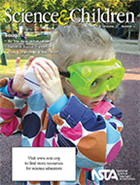Sound
By Mary Bigelow
Posted on 2014-02-24
 This is a wonderful themed issue, with all of the articles focusing on helping younger students investigate and understand the science of sound. Unfortunately for secondary students, the science of sound might not get a lot of attention in the curriculum, but as the editor notes, this is a popular and interesting topic for students. [SciLinks: What Is Sound?]
This is a wonderful themed issue, with all of the articles focusing on helping younger students investigate and understand the science of sound. Unfortunately for secondary students, the science of sound might not get a lot of attention in the curriculum, but as the editor notes, this is a popular and interesting topic for students. [SciLinks: What Is Sound?]
The authors of The Sound of Science* posed an engineering challenge to their students. Students explored vibrations using tuning forks and string telephones, and then were challenged to design and create stringed instruments using a given set of materials and specified criteria. The Connections for this issue has photographs of several of their designs. [SciLinks: Sound]
What causes sound? This question can puzzle older students, but Becoming Attuned to Sound* (this month’s Early Years article) illustrates how our youngest scientists can explore sound and how it’s produced. The article features homemade musical instruments for children to build and explore. [SciLinks: Sound]
Sounds Like Science* (this months Science Shorts article) includes a 5e lesson on Exploring Human Sounds. The activity incorporates the use of an iPad app that demonstrates what sound waves look like. The Science and Technology of Sound* (this month’s Teaching Through Trade Books article) reviews two books and includes lesson ideas on the topic. Sounds All Around for K-2 is a 5E lesson on how we perceive sounds, the workings of the ear, and how sounds are used to communicate. The 5e lesson Animal Sounds introduces students in grades 3-5 to the science of bioacoustics. [SciLinks: The Ear, Hearing, Animal Communication]
The authors of From Vibration to Vocalization* developed a 5E lesson that focused on the characteristics of sound, how it is transmitted, and how it can be visualized featuring the vocalizations of frogs. Close Encounters of the Amphibious Kind* describes a 5E lesson in which primary students used frog calls as the context for studying and investigating sound. If you’ve used KLW graphic organizers with your students, you might be interested in the KLEWS chart described in this article, which updates the chart to include Evidence and Science Principles. [SciLinks: Amphibians, Properties of Sound]
My students loved to act things out in class. The challenge was in channeling this enthusiasm into learning experiences. I wish that we could see videos of what the students did as part of the lesson using Creative Sound Dramatics.* Rather than writing or drawing what they were learning about sound, students used movement to demonstrate their understanding. The article has suggestions for a student exercises to introduce them to this form of expression.
Teaching about sound through students interests in music can be an enjoyable interdisciplinary experience. Do You Hear What I Hear?* describes how science and music educators developed a 5E lesson in which students learn about sound waves created by musical instruments and develop a model of sound waves. Each part of the lesson is described in detail. This month’s Science 101 has some background information on What Determines the Quality of Musical Notes? Including graphics, demonstrations, and a discussion of the quality of timbre. Share this with a music teacher! [SciLinks: Sound Quality]
The authors of Pinging: Sound at Work (this month’s Recognizing Excellence article) describe the partnership between a NOAA Teacher at Sea paraticipant and an elementary class to develop a hydrography learning center, focusing on the use of sound as a tool. The article describes the resulting center comprised of a sounding boxes, creating a model of the seafloor, a book center, and a WebQuest. [SciLinks: Sonar, Ocean Floor, Speed of Sound]
*And check out more Connections for this issue (February 2014). Even if the article does not quite fit with your lesson agenda, there are ideas for handouts, background information sheets, data sheets, rubrics, and other resources.
Disclaimer: The views expressed in this blog post are those of the author(s) and do not necessarily reflect the official position of the National Science Teaching Association (NSTA).

